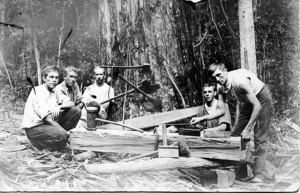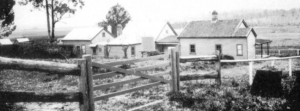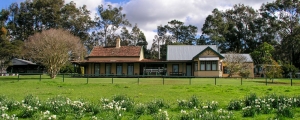The Darkinjung aboriginal tribe were the first inhabitants of the area around Wyong dating back well before European settlement in Australia. The Awabakal people lived on the coast and the Guringai further south on either side of Broken Bay.
The history of Alison Homestead dates back to 1825 when Govenor Brisbane granted William Cape and his sons three parcels of land, amounting to 2500 acres, around Wyong. Alison Homestead sits on part of that land grant. They did not spend much time on the properties as they were school teachers in Sydney. However in his retirement, William Sr lived on the property for almost 15 years and during that time he created weekly weather tables that were published in prominent newspapers and which subsequently provided valuable reference material for meteorologists. After William Cape Jr retired he became the elected member for Wollombi in the legislative assembly. His achievements were many and varied but sadly his skills were lost to Australia when he returned to England where he died of smallpox at the relatively young age of 56.
In 1875 William Alison purchased the three properties. William’s son Charles lived on the property for a while and he spent his time improving the pasture and grazing cattle. The late 1880s were busy years with the opening of the railway from Newcastle to Wyong. Charles set up a sawmill near the site of the present railway station to process the cedar from the booming timber industry in the Yarramalong Valley. He donated land for a public school in Wyong, as well as for a Post Office and School of the Arts.
Charles was affected by the economic depression of the late 1890s and sold the property in 1902 to a local developer who subdivided it into farming and dairying blocks and put them up for auction. The original land grant area now encompasses 10 suburbs and approximately 36,000 residents.
Between 1909 and 1918 there were many ownership changes for the remaining property until it was purchased by the Pearce family in 1919. They already owned a market garden and flower shop in Sydney and Arthur Pearce and his wife moved into set up a plant nursery and flower farm providing flowers for both Sydney and Newcastle. In the 1950s the Pearces made improvements to the homestead including an updated bathroom, laundry and kitchen.
By the 1970s the flower growing business had ceased and the Pearces sold the property to become part of the land required for the building of the Sydney to Newcastle freeway. The site remained neglected until 1987 when, after much lobbying from the Wyong District Museum & Historical Society, Wyong Council purchased the property and the conservation of the Homestead began.
In 1988 the Historical Society arranged to lease Alison Homestead from Council and in 1992 the museum exhibits were moved from Tuggerah Church to the Homestead. It became a popular destination for the local community and visitors to the area who came to visit the Museum, attend a variety of events held onsite and use the grounds for family and groups functions.
In December 2011 the Homestead was the target of an arson attack which destroyed most of the original Homestead and the displays in the Museum.
The other buildings on the site survived the attack. The rebuild of the Homestead took 4 years to complete and the local community generously donated many items of memorabilia to replace what was lost in the fire. The Museum reopened in October 2015.
 EDWARD STINSON
EDWARD STINSON
WYONG HISTORIAN
Edward Hamilton Stinson was born at Newcastle on November 1, 1912, the oldest of four children born of the marriage between Thomas Stinson of Yarramalong and Elizabeth Taylor of Cooranbong.
He is a descendant of two of this area’s oldest and most notable pioneering families. His maternal great-grandfather was Edward Taylor who settled at Blue Gum Flat about 1840 and he is a grandson of Hamilton Stinson who as a 16 year old boy came into the forested wilderness of Yarramalong in June 1856 and became a successful settler there.
Edward Stinson’s early years were spent at Yarramalong on the 400 acre property of his father who was a timber merchant, grazier, dairy farmer, citrus orchardist and company director, a judge at the Newcastle shows, president of most district organisations and noted throughout the Wyong area as a fine and popular public speaker.
In 1920 at the age of 7 Edward became a pupil at the local Yarramalong School which he attended for 5 years, then went away to boarding school for 5 years at prestigious St. Joseph’s College at Hunters Hill in Sydney where he had the privilege of a GPS education.
After completing his secondary education there, he went on to Sydney Teachers’ College and started his teaching career when he was a few months short of his 22 birthday. For the next 38 years he taught in many parts of NSW, including 23 years in charge of the local school at Cedar Brush Creek where he taught two generations of pupils.
From choice, most of his teaching years were spent in isolated little one teacher schools which he much preferred to the large city schools. He did serve for some time in a large staffed school (Lithgow) but the experience was not a happy one for him.
To use his own words: “I found the repressive, conformist and authoritarian atmosphere of a large staffed school intolerable, so I went back to the little bush schools that I loved, and stayed there.”
He was appointed in charge of the local Tacoma School in 1972 but after a few months there suffered a serious health collapse and was compulsorily retired for medical reasons, but he still continued to teach privately as a Mathematics coach.
His most notable achievement is his vast collection of material and his voluminous writings on the history of the Wyong area. Those who have had the privilege of looking over his wonderful collection of historical pictures (there must be nearly 3000 of them) can only marvel at it and be grateful to him for noone else in the 150 years of Wyong’s history has ever seriously attempted, much less achieved what he has accomplished, and as a result of his labours and the researches of this dedicated man, posterity will find in his irreplaceable collections and in his writings, a whole treasury of information relating to our local history, most of it unavailable from any other source.
For just 6 years from October 1973 he contributed a long series of articles (nearly 300 of them) on the history of the Wyong area, which were published weekly in the Tuggerah Lakes Advocate newspaper, with enough material to fill 6 books. These books are available for purchase here on our website.
Edward lived for the greater part of his life at Hillview with his brother, Harry, and died in 1989. They were bachelors. Hillview was the family home a few metres down from, and opposite, the entrance to Stinson’s Lane. His hobbies were reading, writing, listening to music, solving cryptic crossword puzzles, enjoying the company of his many friends and walking in the great world of nature which quite fascinated him.


